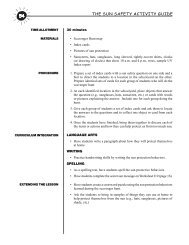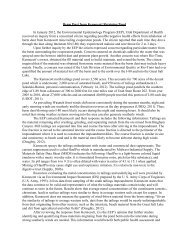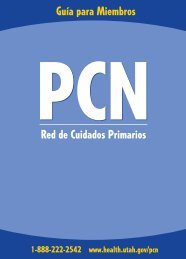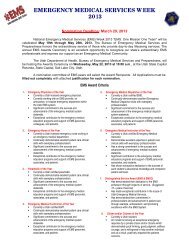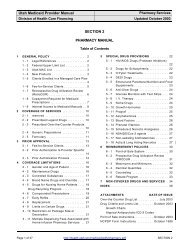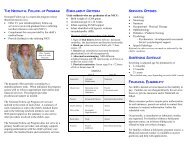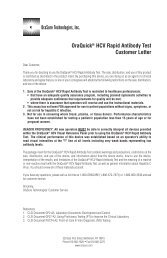Primary Children's Medical Center Trauma Process - Utah ...
Primary Children's Medical Center Trauma Process - Utah ...
Primary Children's Medical Center Trauma Process - Utah ...
Create successful ePaper yourself
Turn your PDF publications into a flip-book with our unique Google optimized e-Paper software.
Tia Dalrymple RN, BSN<br />
<strong>Trauma</strong> Charge Nurse at PCMC<br />
EMSC Clinical Nurse Consultant<br />
6/21/2012
What Should We Learn Today?<br />
• Review the PCMC trauma process<br />
• Discuss Pre-hospital communication
<strong>Trauma</strong> <strong>Center</strong> Designation<br />
• Level I <strong>Trauma</strong> Care<br />
– IMC, PCMC, University of <strong>Utah</strong><br />
• Level II <strong>Trauma</strong> Care<br />
– Ogden Regional, Mckay-Dee,<br />
<strong>Utah</strong> Valley Regional<br />
• Level III <strong>Trauma</strong> Care<br />
– Logan Regional, Dixie Regional<br />
• Level IV <strong>Trauma</strong> Care<br />
– Bear River, Moab Regional,<br />
Timpanogos, Mt. View, Brigham City,<br />
Cache Valley, Park City, Unitah Basin,<br />
American Fork, Heber Valley<br />
• Level V <strong>Trauma</strong> Care<br />
– Fillmore Community
<strong>Trauma</strong> Two<br />
– GSC 10<br />
– Multiple or serious injury (without evidence<br />
of airway compromise of shock)<br />
– High energy mechanism<br />
–
NP<br />
Sec<br />
Res.<br />
RN<br />
Picu<br />
Tech<br />
RT<br />
RT<br />
Tr<br />
Surg<br />
Phm<br />
Picu<br />
RN<br />
<strong>Trauma</strong> 2 <strong>Trauma</strong> 1<br />
<strong>Trauma</strong> 1 OP <strong>Trauma</strong> 1 OP<br />
Neuro<br />
<strong>Trauma</strong> 1<br />
OP ECMO<br />
Phlb<br />
An NS<br />
2 nd<br />
RN<br />
Dc<br />
CT<br />
ECMO<br />
OR<br />
S<br />
W<br />
Rad
• EMS Role<br />
– Enter (feet first )into the<br />
trauma room and report last<br />
set of vitals<br />
– Transfer to the gurney<br />
– Help in removal of clothes,<br />
straps and monitors, removal<br />
of transport gurney from the<br />
room<br />
– Complete EMS report by<br />
completing the VTRAIN<br />
pneumonic<br />
– Observe from the back of the<br />
room or exit as directed<br />
The PAR <strong>Trauma</strong>
Feel the love…<br />
• Lead placement<br />
• Taping the IV<br />
• Weights in report<br />
• C-collar in place/C-spine secure
What was that entry code again?
Performance Measures<br />
• Attending trauma surgeon is expected to be in room at the arrival of the<br />
patient with pre-notification or within 15 minutes of patient’s arrival with<br />
no pre-notification.<br />
• The patient will be taken to CT within 30 minutes.<br />
• Patient to PICU within 1 hour of arrival to ED.<br />
• Other tracked items<br />
Non surgical admissions<br />
Complications<br />
Mortalities<br />
Missed Injuries<br />
Hospital Acquired infections<br />
Decubitus<br />
Consultation services<br />
Communication<br />
Pre-admission care
<strong>Trauma</strong> Charge Nurse Role<br />
9 specialized nurses with at least 3 years PCMC ED<br />
experience and completion of the ED <strong>Trauma</strong> Education<br />
Module.<br />
• Act as lead RN on all trauma activations.<br />
• Coordinates care of critical patients in the department.<br />
• Liaison between the trauma team and the ED.<br />
• Orients nurses in the ED to the trauma process.<br />
• Attends trauma M&M, process improvement, and facilitate change when needed.
PCMC EMS Liaison<br />
Ruth Seed RN<br />
PCMC Emergency Department<br />
Quality/Infection Control Expanded Role<br />
And EMS Liaison
Overall Goal<br />
• Be aware of the “big picture”<br />
• Injury prevention, ongoing trauma education<br />
and rehabilitation of the patient are all part of<br />
the “<strong>Trauma</strong> System”
EMSC<br />
Emergency <strong>Medical</strong> Services for Children<br />
Pre-hospital Provider Education<br />
Injury Prevention Programs<br />
Provision of Pediatric Equipment<br />
Statewide Needs Assessments<br />
CSHCN Programs<br />
National Performance Measures<br />
Pediatric Strike Teams<br />
Conference Support
In a Perfect World…<br />
• Dispatch will call the ED as soon as<br />
they dispatch the flight.<br />
• The <strong>Trauma</strong> Charge Nurse (TCN)<br />
will send out a pre-page which<br />
gives a heads up to the PICU and<br />
the <strong>Trauma</strong> Team.<br />
• The flight crew will call with a<br />
patient status report and ETA…at<br />
least 30 minutes prior to arrival.<br />
• The TCN will then send out the<br />
official page and assemble the<br />
proper team.
The Real World…<br />
• What are some barriers<br />
to pre-hospital<br />
communication?<br />
• Is an “at least 30 minutes<br />
ETA” reasonable?<br />
• What information would<br />
you like from PCMC prehospital<br />
and on arrival?



